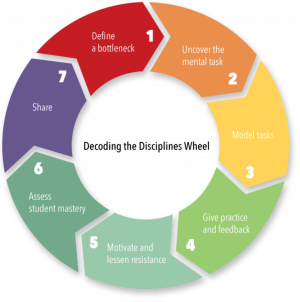Decoding the Disciplines is a process for increasing student learning by narrowing the gap between expert and novice thinking. Beginning with the identification of bottlenecks to learning in particular disciplines, it seeks to make explicit the tacit knowledge of experts and to help students master the mental actions they need for success in particular courses.
Steps in the Decoding process
The Decoding process is structured in seven steps.[1][2][3] The order of the steps is not mandatory and can be changed as needed.
Step 1: Identify a bottleneck to learning
Instructors identify an activity or task in your course that students are supposed to learn but often fail. The activity may well be a mental activity.
Step 2: Uncover the mental tasks needed to overcome the bottleneck
Instructors explore in depths the steps that disciplinary experts go through to accomplish the activity or task identified as a bottleneck.Often step 2 is carried out via a Decoding Interview with typically two interviewers helping the instructor to make his or her expertise explicit.
Step 3: Model these tasks
Instructors give their students the opportunity to observe how they accomplish these activities as an expert.In order to do so, instructors may
• perform the (mental) steps in front of your students using a subject-specific example.
• explicitly highlight critical operations.
• use metaphors or analogies for the (mental) steps.
Step 4: Give students practice and feedback
Instructors provide their students with tasks or learning activities that allow students to perform the activity identified as a bottleneck and receive feedback.
Step 5: Motivate and lessen resistance
The Decoding the Disciplines process can lead to considerable changes in teaching. Students might resist such changes. Step 5 is to anticipate such in order to better cope with them.
Step 6: Assess student mastery
Instructors give assessments that provide information on the degree to which students can perform the activity identified as a bottleneck.
Instructors share their findings informally with colleagues or more formally through publications or presentations as a form of Scholarship of Teaching and Learning.
History
Decoding the Disciplines has been pioneered by Joan Middendorf and David Pace at Indiana University. David Pace has summarized intentions and goals of this early phase of Decoding the Disciplines as follows:[4]
The Decoding the Disciplines approach emerged from a desire to develop new responses to common blocks to learning in college courses. As directors of the Indiana University Freshman Learning Project from 1998 to 2010, Joan Middendorf and David Pace perceived a mismatch between what was being taught to students in many classes and what was actually required for success in these courses. The very expertise of college instructors had made many essential procedures of the disciplines so automatic that these had become invisible and, thus, were not being taught. Students, trying to respond to the demands of their courses, were often unintentionally given conceptual maps of the field that lacked instructions for surmounting crucial challenges. It was as if their instructors had provided their students with the kind of itinerary produced by Google Maps, but had inadvertently omitted many lines of the instructions. Students who were already familiar with the territory found their way with little difficulty. A few students with usual skills at pathfinding turned the limited set of clues at their disposal into a strategy for reaching the destination. But others, who were not pre-educated in the field or endowed with a special predisposition for the discipline, became hopelessly lost.
Decoding the Disciplines as a framework
Decoding is highly integrated and integrative. It combines elements of research on expertise and misconceptions, of professional development, of coaching, of collegial counseling, and of Scholarship of Teaching and Learning into a process of teaching development, which acknowledges the difficulties students have in learning subject-specific patterns of thought and action as inherent to processes of teaching and learning. Decoding focuses on the difficulty of the subject matter in a systemic way. It avoids infertile thinking that seeks the failure of teaching primarily among students, or in a wrong selection of teaching method.
References
- ↑ Middendorf, J.; Pace, D. (2004): Decoding the disciplines: A model for helping students learn disciplinary ways of thinking. New directions for teaching and learning, 2004(98), 1 – 12.
- ↑ Middendorf, J.; Shopkow, L. (2018): Overcoming Student Learning Bottlenecks. Sterling: Stylus
- ↑ Pace, D. (2017): The Decoding the Disciplines Paradigm - Seven Steps to Increased Student Learning. Bloomington: Indiana University Press
- ↑ Pace, D. (2021). Beyond Decoding the Disciplines 1.0: New directions for the paradigm. Teaching and Learning Inquiry, 9(2).
